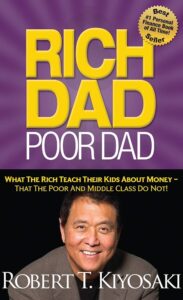Rich dad poor dad summary
Rich Dad Poor Dad is a seminal book by Robert Kiyosaki that challenges traditional notions of employment, investment, and wealth acquisition. The book chronicles the experiences of Kiyosaki growing up influenced by two fathers, his biological father (Poor Dad) and his best friend’s father (Rich Dad), each with very different views on wealth and success.
Table of Contents
The Main Characters in Rich Dad Poor Dad
The two pivotal characters in Rich Dad Poor Dad are:
- Poor Dad: Kiyosaki’s biological father, a well-educated man who holds a high-income job, but struggles financially due to his traditional views on money and investment.
- Rich Dad: Kiyosaki’s friend’s father, a businessman teaches Kiyosaki about financial independence and wealth creation through unconventional means.
Core Principles in Rich Dad Poor Dad
The Rich Mindset in Rich Dad Poor Dad
A rich mindset is not about having an abundance of money, but about approaching finances with an open and educated mind. This includes having long-term visions, being willing to take calculated risks, and continuously learning and enhancing financial literacy.
The Importance of Financial Education in Rich Dad Poor Dad
In Rich Dad Poor Dad, Kiyosaki emphasizes that financial education is crucial. An understanding of concepts like investing, making money work for you, and leveraging assets can break the cycle of living paycheck to paycheck.
Work to Learn, Not Earn
Rich Dad Poor Dad advises readers to work to learn, not earn. This implies choosing jobs that offer skills and knowledge over immediate monetary returns. These skills can then be leveraged to build financial independence in the long run.
Learning How to Invest From Rich Dad Poor Dad
Investments can be daunting. However, in Rich Dad Poor Dad, readers are introduced to the idea of investment learning. It educates readers about strategies to invest wisely in assets like real estate and shares to accumulate wealth.
Understanding Assets and Liabilities in Rich Dad Poor Dad
The book drives home the importance of understanding assets and liabilities. It states that the rich pursue assets – things that put money into your pocket, and the poor and middle-class accumulate liabilities – things that take money out of your pocket.
The Impact of Rich Dad and Poor Dad
The book’s influence is visible in how it has revolutionized people’s attitudes towards money around the world. An introduction to financial literacy, the impact of Rich Dad Poor Dad includes inspiring readers to strive for financial independence using unconventional ways rather than traditional employment.# Deep Dive into Rich Dad Poor Dad Summary
In Rich Dad Poor Dad, Robert Kiyosaki shares the lessons he learned from his two ‘dads’ concerning money management, investing, and financial independence. Detailed below is an exhaustive exploration of these teachings.
The Rich Don’t Work for Money
Contrary to popular belief, Kiyosaki asserts that the “rich don’t work for money”, emphasizing that the wealthy have learned how to make money work for them.
- They invest in assets that generate passive income, such as real estate, businesses, and stocks, which generate regular income without demanding their active involvement.
- The rich understand the importance of financial independence and the value of having money work for them, instead of trading their precious time for money.
Why Teach Financial Literacy?
“Financial literacy in Rich Dad Poor Dad” is highlighted as a critical competency that should be imparted in every learning environment.
- Kiyosaki argues that comprehensive knowledge about money, investments, and financial markets can help individuals make informed decisions about their financial resources.
- By understanding money’s language, individuals may better manage, invest, and grow their wealth over time.
Minding Your Own Business
Kiyosaki stresses the concept of “minding your own business” in the book and provides insight into creating and managing personal financial empires.
- He encourages readers to start their own businesses, investing in assets rather than working under someone else’s business model.
- This approach allows for autonomy and the opportunity for greater wealth accumulation and financial security.
Power of Corporations
Kiyosaki elucidates on the “power of corporations”.
- He explains how wealthy individuals create corporations, which offer benefits such as lower tax rates and legal protection of personal assets.
- Kiyosaki advises readers to follow suit and utilize the legal and financial perks that corporations offer.
Overcoming Obstacles
Robert Kiyosaki talks about “overcoming obstacles” in the pursuit of financial independence in the book.
- The hurdles range from fear, cynicism, laziness, bad habits, and arrogance.
- The author believes that shaping one’s attitude and behaviors positively and constructively can help overcome these obstacles.
Criticisms and Controversies of Rich Dad Poor Dad
Despite its popularity, “Rich Dad Poor Dad” has faced several criticisms.
- Some critics argue that the book overly simplifies complex financial concepts and investments.
- There is contention over the existence of the ‘Rich Dad,’ which adds skepticism to the book’s authenticity and the validity of its advice.
- Others claim Kiyosaki promotes risky investment strategies without considering individual financial circumstances.
FAQs on Rich Dad Poor Dad Summary
What is the main concept of Rich Dad Poor Dad?
The main concept of Rich Dad Poor Dad revolves around the starkly different financial philosophies imparted by the author’s two father figures – his own father (Poor Dad) and the father of his best friend (Rich Dad). It teaches readers about financial literacy, asset ownership, and the mindset required to achieve financial independence.
How does Rich Dad Poor Dad explain the importance of financial education?
Rich Dad Poor Dad emphasizes the significance of financial education by highlighting how traditional schooling often neglects to teach practical money management skills. The book encourages readers to educate themselves about money, investing, and building wealth through real-world experiences rather than solely relying on formal education.
What are some key principles discussed in Rich Dad Poor Dad?
Some key principles explored in Rich Dad Poor Dad include the mindset of being rich, the value of financial education, the concept of working to learn rather than just earn, the importance of investing, and distinguishing between assets and liabilities in personal finance.
How does Rich Dad Poor Dad address the issue of working for money?
Rich Dad Poor Dad challenges the notion of working solely for a paycheck by advocating for creating passive income streams, investing in income-generating assets, and focusing on financial independence rather than being stuck in the cycle of working for money.
What are some criticisms of Rich Dad Poor Dad?
While many readers find value in the teachings of Rich Dad Poor Dad, some criticisms include the simplistic writing style, lack of concrete financial advice, and skepticism towards some of the author’s claims about his personal experiences and financial success.
Conclusion – The Lasting Impression of Rich Dad Poor Dad
The “lasting impression of Rich Dad Poor Dad” is undeniable.
- It remains a pivotal book that has shaped the understanding of finance and investment for millions worldwide.
- Despite criticisms, its emphasis on financial literacy, owning assets, and cultivation of a rich mindset offers readers invaluable financial education.
- Its influence continues to resonate, encouraging countless individuals to reconsider their financial practices and strive toward financial independence.

